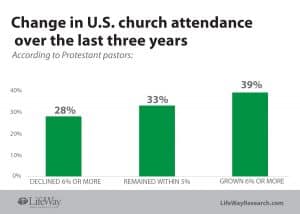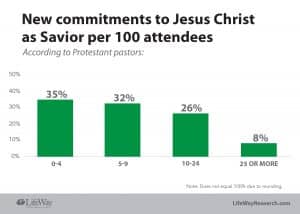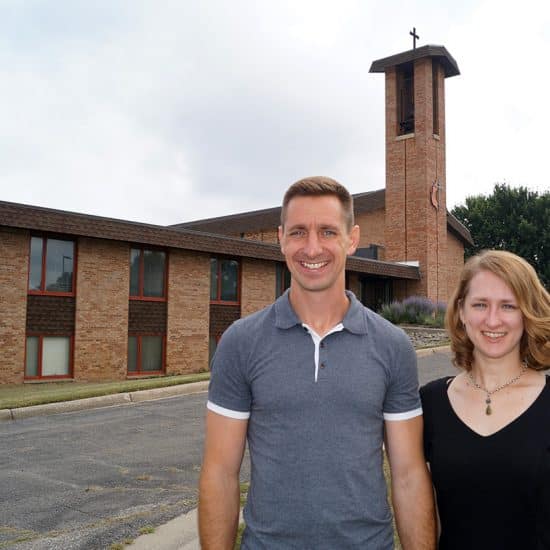

In a new study conducted by LifeWay Research, 28 percent of Protestant pastors say their church has seen worship attendance shrink by 6 percent or more compared to three years ago. Image by Rhomphaia on Pixabay
NASHVILLE (BP) — Many churches are not seeing new faces in the pews, according to a new study from Exponential conducted by LifeWay Research.
Six in 10 Protestant churches are plateaued or declining in attendance, according to data released March 6. More than half saw fewer than 10 people become new Christians in the past 12 months.
Exponential is a Virginia-based organization focusing on resources for church planting and multiplication.
“Growth is not absent from American churches,” said Scott McConnell, executive director of LifeWay Research. “But rapid growth through conversions is uncommon.”
The research gives a clear picture of the state of Protestant churches in America today. Most have fewer than 100 people attending services each Sunday (57 percent), including 21 percent who average less than 50. Around 1 in 10 churches (11 percent) average 250 or more in worship.
Three in 5 (61 percent) pastors say their churches faced a decline in worship attendance or growth of 5 percent or less in the last three years. Almost half (46 percent) say their giving decreased or stayed the same from 2017 to 2018.
More than 2 in 5 churches (44 percent) only have one or fewer full-time staff members. Nearly 9 in 10 pastors (87 percent) say their church had the same or fewer number of full-time staff in 2018 as they had in 2017, including 7 percent who cut staff.
In 2018, 32 percent of churches were involved in some form of planting a new church; 3 percent added new multi-site campuses. Around 1 in 10 (12 percent) say they were directly or substantially involved in opening a new church in 2018, including 7 percent who were a primary financial sponsor or provided ongoing financial support to a church plant.
“The primary purpose of this study was to obtain a set of objective measures on churches’ reproduction and multiplication behaviors today as well as to understand their core context of growth,” said Todd Wilson, chief executive officer of Exponential. “By combining these measures, we can help churches think about multiplication.”
Declining, plateaued or growing?
 Twenty-eight percent of Protestant pastors say their church has seen worship attendance shrink by 6 percent or more compared to three years ago.
Twenty-eight percent of Protestant pastors say their church has seen worship attendance shrink by 6 percent or more compared to three years ago.
Another 33 percent say their church has remained within 5 percent, while 39 percent say their congregation has grown by at least 6 percent since the first quarter of 2016.
More than half of 18- to 44-year old pastors (55 percent) say their church is growing, while 33 percent of pastors 45 and older say the same.
Evangelical churches are more likely to be growing (42 percent) than their mainline counterparts (34 percent).
Less than a quarter (23 percent) of churches with an average worship attendance of fewer than 50 say they are growing, while most churches with 250 or more in attendance (59 percent) are growing.
Among denominations, Holiness (56 percent) and Baptist (45 percent) pastors are more likely to say their churches are growing than Methodists (33 percent) and Lutherans (25 percent).
Church conversions
 The lack of growth in worship attendance in most churches is matched by a lack of new commitments to Christ last year.
The lack of growth in worship attendance in most churches is matched by a lack of new commitments to Christ last year.
Fifty-four percent of pastors say fewer than 10 people indicated a new commitment to Jesus Christ as Savior in 2018, including 8 percent who had none.
In some ways, however, those numbers mask deeper evangelistic concerns. When evaluating churches based on the number of conversions per 100 attendees, 67 percent had fewer than 10 per 100 people attending their church. Around a third (35 percent) had fewer than five new commitments for every 100 people attending their worship services.
Among churches of 250 and above, 18 percent say they had 10 conversions or more for every 100 in attendance.
While there are no major differences between evangelical and mainline churches in terms of new converts, denominational differences do exist.
A majority of Pentecostal pastors (57 percent) say they saw 10 or more new commitments to Christ in their church last year per 100 attendees. The next closest denominations are Lutherans (39 percent), Holiness (38 percent) and Baptists (35 percent).
A quarter of Methodist (25 percent) and Presbyterian or Reformed pastors (23 percent) say they had 10 or more new commitments to Jesus in 2018 per 100 attendees. Half of Methodist pastors (50 percent) had fewer than five new commitments last year.
“Much work has been done to go deeper on measuring church health,” said McConnell. “But it is still helpful to look at the observable factors of ‘noses, nickels and new commitments.’ Strategies, programs and rules-of-thumb work differently depending on the trajectory of a church.”
Methodology: A phone survey of 1,000 Protestant pastors was conducted by LifeWay Research Jan. 14–30, 2019. The calling list used a random sample stratified by church size, drawn from a list of all Protestant churches. Quotas were used to maintain the correct proportion of each church size. Responses were weighted by region to more accurately reflect the population. Each interview was conducted with the senior pastor, minister or priest of the church called. The sample provides 95 percent confidence that the sampling error does not exceed plus or minus 3.2 percent. Margins of error are higher in subgroups.



